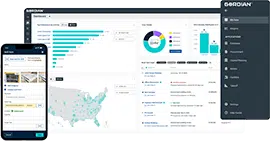Higher Ed Construction Insights from Robert Unger
As government funding and enrollment continue to decline, public universities have fewer financial resources to maintain and renovate their facilities.
The Pennsylvania State System of Higher Education (PASSHE) is a 14-school public university system serving more than 100,000 students across the Keystone State. PASSHE owns approximately 900 buildings, totaling around 30 million square feet. Each university operates relatively independently with their own professional facilities staffs to execute a variety of projects.
As Director of Construction Management for PASSHE, Robert Unger supports the universities’ facilities staffs’ needs and expectations. He talked to us about challenges facing schools in the PASSHE system, the keys to a successful construction project, and his experience using Gordian’s ezIQC® solution to complete deferred maintenance and small renovation projects.
How do you assist PASSHE universities in your role as Director of Construction Management?
All the projects are executed by the universities. My office provides guidance, policy, oversight and coordination to assist those universities in the execution of their projects. That involves creating and maintaining standard contract forms, and procedures manuals, on top of providing a lot of specific guidance. We also hold semiannual training conferences for the universities’ contract specialists and project managers. Lastly, we procure and maintain three different sets of central contracts for open-ended professional services, such as architects, engineers and construction managers.
What are some challenges facing higher education construction management in Pennsylvania?
First, there’s enrollment. In recent years, fewer students have graduated from Pennsylvania high schools, our System’s greatest source of students. Our total PASSHE enrollment is 12 to 14 percent less than what it once was. Since tuition contributes to such a high percentage of our operating budgets, a 12 to 14 percent drop in students has a major effect.
Also, our commonwealth appropriations have not kept up with our rising costs. Years ago, our direct appropriations represented more than 50 percent of our operating budgets; today, our direct funding makes up only about 21 percent of our operating budgets.
Combine these two things, and as our operating budgets shrink, our universities are challenged to maintain properly-staffed teams of project managers and contract specialists to adequately procure and administer contracts and execute projects.
 You have decades of experience in construction management. What makes for a successful project?
You have decades of experience in construction management. What makes for a successful project?
I would identify three best practices:
The first is planning. If you figure out what you want to do, what you need to do, and how you’re going to do it, before you start, rather than making things up on the fly and changing course as you go, a project has a far greater chance of succeeding.
Next, it is important to have solid plans and specs. I don’t know how many jobs I’ve seen on the construction side where somebody rushed the project out the door and bid it just to execute it on schedule before the plans and specs were ready. Well, that just creates a lot of extra work for people in the field.
Finally, open and effective communications between every member of the project team, to include the owner, the construction contractors, the design professional, the user or occupant of building, and also your own internal management staff, helps a project succeed. Just keeping communications flowing, letting everybody know what’s going on can help a project run smoothly.
Those three best practices—planning, solid specs and open communications—they are the keys to construction project success.
What types of construction projects does PASSHE use ezIQC to complete?
Our System’s universities access job order contracting via the Keystone Purchasing Network, a national purchasing cooperative that serves schools and other public agencies. The projects we complete using these job order contracts are smaller renovation and deferred maintenance projects. We have a policy which limits the use of these contracts to projects under $500,000, but, in reality, most of them are under $100,000. This could include replacing a roof, renovating classrooms for modern IT and AV systems or refreshing the carpet, paint and windows.
Why does PASSHE utilize ezIQC as an alternative construction procurement method?
First is the simplified procurement process for a work order. A university can execute a work order by having an on-site scope meeting, receiving a proposal, and quickly executing a work order form with a JOC contractor to get a project started.
The second reason is the overall time savings. We can get projects completed faster because we’re not going through the iterative steps of preparing plans and specs, bidding, securing contracts, and getting legal approval. That all takes a long time.
The third reason is the convenience of making changes during the work. It’s a lot easier to adjust quantities from the price proposal than it is to negotiate a change order.
There’s not one solution or process for everything, but ezIQC is an excellent tool to provide flexibility in our contracting toolkit.
About Robert Unger



 You have decades of experience in construction management. What makes for a successful project?
You have decades of experience in construction management. What makes for a successful project?


